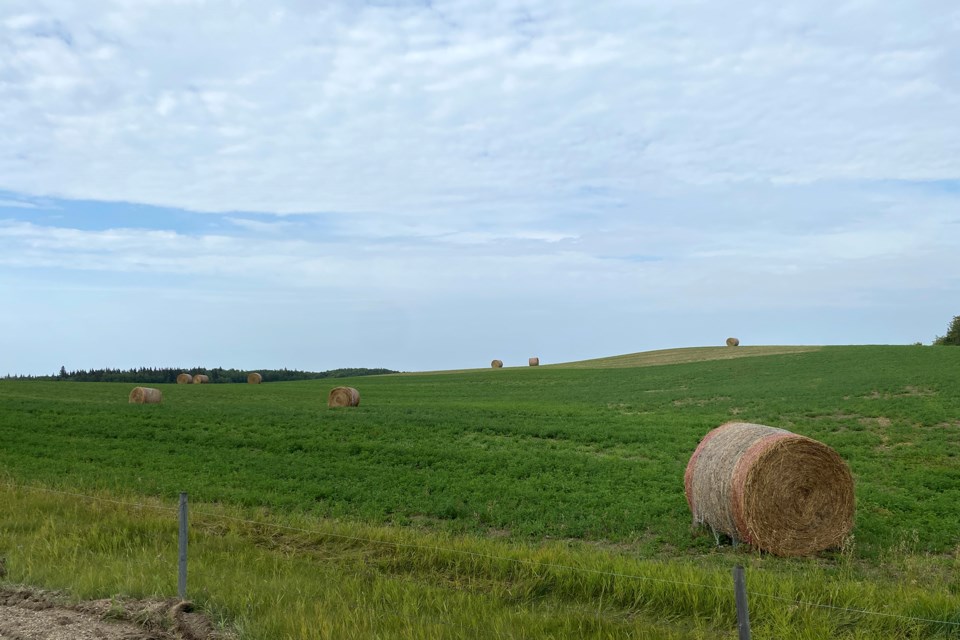LAKELAND – With the summer now wearing off, local producers have had a good haying season, setting them up well for the upcoming fall and winter seasons.
Keith Kornelsen, agricultural fieldman at the County of St. Paul, said pastures are doing okay, and farmers in the area are getting more than an average yield with hay.
There should be enough hay for cattle in the area, “so, it’s not really a concern,” said Kornelsen, acknowledging that in some areas of southern Alberta there has been a significant lack of moisture.
“I would say we have adequate moisture,” he said, while also recognizing some areas may be better off than others. “But... we’re average.”
On average, farmers in the St. Paul region typically only get one cut of hay, said Kornelsen.
Overall, cattle herds do seem to be getting smaller in the area, noted Kornelsen, which is due to several factors. For example, some farmers are not seeing great returns on their cattle, and others are retiring from the industry.
Speaking of pests like grasshoppers, Kornelsen said that while there are many out there, it is not to a degree that matters. “I don’t know if they’re having a big impact on the yield of the pasture,” he said.
While pest control is an ongoing matter within the County, this year it does not seem to be a big issue.
Lac La Biche
Jacob Marfo, agriculture fieldman with Lac La Biche County, said there is a high need for hay in the County due to its many livestock producers, most being beef cattle. And thanks to the favourable weather conditions in the region, hay production “has been very good” this season.
Some farmers are waiting for a second cut, which may still come. “I know other municipalities have declared a drought,” but the Lac La Biche region has seen plenty of rain.
Speaking of challenges that may exist, grasshoppers are a major issue this year, especially in the southern part of the County where there seems to be a grasshopper infestation.
“The population is high,” and grasshoppers look to have come early this year. In prior years, grasshoppers usually appear around or close to August, but they have appeared as early as June this year.
Asked if this resulted in any negative consequences, Marfo said that the County has not done any tests to determine the impact on hay quality, but due to favourable weather conditions, “I don’t think there’s going to be significant damage to the industry.”
Overall, hay production has been good, “So I think this year is better than the previous years.”
Bonnyville
Matt Janz, general manager of the M.D. of Bonnyville’s environmental and protective Services, said that for the M.D., hay production is on the poor side in some areas due to the high number of grasshoppers, but overall producers are faring well.
“I would say on average, it would be okay here - a good year.”
Most farmers are getting anywhere from a bale and half per acre, and some are getting two bales per acre, he added.
Speaking to the grasshopper situation, in some areas, “It is quite bad,” said Janz. North of the Beaver River, on the more northern side of the municipality, “We definitely see higher grasshopper numbers eating some of the hay crops and pastures.”
Most forage crops like hay crops at the moment are around 80 per cent complete, he said.
As for pastures, “One of the challenges I hear from our farmers is dugouts, so water for livestock,” added Janz. Dugouts are on the lower side, so farmers are looking at alternative water sources for their animals, due to the lack of runoff in the spring, he said.
Asked if this will affect cattle in the area, Janz said it will. Farmers are moving cattle to different pastures with better water sources, or they might move cattle to hay fields that have already been baled. “So, it does play a little bit into the hay situation.”
There are also concerns about the increase of hay prices in the province, which is costing farmers more to feed their cattle. In addition, farmers are still recovering from the drought experienced over the last few years.
“They haven’t grown their cattle herds at all, I don’t think so... I haven’t heard anybody selling off any cattle this year, but I don’t think they’re keeping extra animals around either,” said Janz. “But as far as I know, most people are able to keep their cattle and they might just have to move them around to different pastures.”
Asked what the outlook for the rest of haying season is, and the overall agricultural outlook in the M.D., Janz said production of either cattle, grain, or pastures “looks to be decent... good, I would say,” because of timely rains that came this year.
“That will get us by until the end of the season. It seems we still have some rain in the forecast and we’re already sitting here in August. So, we can do with a couple more good rains... it’s definitely looking more positive here than it is elsewhere in the province.”



